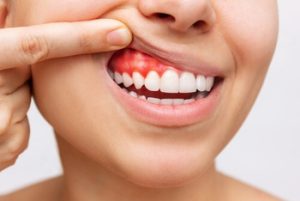Imagine this: You’re biting into your favourite snag (or fairy bread if you prefer), and suddenly—WHAM! A pain shoots through your jaw like a rogue boomerang. Your tooth feels like it’s pulsating to the beat of a heavy metal band, and there’s a weird lump growing on your gum that wasn’t there before. Uh oh, that might be a tooth abscess, mate!
Don’t worry, though. We’ve all been there (well, maybe not all of us, but enough to know it’s no fun). This article will be your lifesaver (or toothsaver?) We’ll break down what happens when a tooth abscess decides to burst open like a party piñata filled with—well, let’s just say it’s not lollies. We’ll also explore what causes these nasty buggers and why a visit to the dentist is more important than ever (even if needles aren’t exactly your cup of tea). We’ll even give you some tips to keep these ouches from becoming a thing of the past.
From Sneaky Slime To Eruption Time: The Stages Of A Tooth Abscess
A tooth abscess doesn’t just appear out of the blue (although it might feel that way when the throbbing pain hits!). This unwelcome guest develops in stages, and understanding them can help you identify potential problems early on. Let’s take a peek at the sneaky journey of a tooth abscess:
Stage 1: Party Time Gone Wrong (Plaque Buildup)
The whole thing starts with a little shindig in your mouth—a party thrown by bacteria! These tiny critters love to munch on leftover sugar and starches from food, leaving behind a sticky film called plaque. If you don’t brush and floss regularly, this plaque builds up, creating a breeding ground for even more bacteria.
Stage 2: From Slime To Trouble (Dentin Decay)
If the plaque party gets too wild, it can lead to a cavity. Bacteria burrow through the tough outer layer of your tooth (enamel) and reach the softer dentin layer underneath. This is where things start to get uncomfortable, as the dentin contains tiny tubes that connect to the nerve centre of your tooth.
Stage 3: Invasion Of The Tooth Pulp (Pulp Infection)
Uh oh! The bacteria haven’t stopped at the dentin. They’re now invading the pulp, the soft tissue inside your tooth that contains nerves and blood vessels. This is where the real party crasher arrives: inflammation. The pulp gets inflamed and swollen, putting pressure on the nerves and causing that awful, throbbing toothache.
Stage 4: The Big Bang (Abscess Formation)
With all this inflammation and nowhere to go, the body’s white blood cells rush in to fight the infection. This creates a pocket of pus (infected material) at the tip of the tooth root (periapical abscess) or between the tooth and gum (periodontal abscess). This is the official formation of your unwelcome guest—the tooth abscess.
Stage 5: Eruption Time (Abscess Rupture)
In some cases, the pressure from the pus buildup can become too much, and the abscess bursts (ruptures). This might provide temporary relief from the pain as some of the pus drains away. However, it’s important to remember that the infection is still very much present!
Don’t Let These Nasties Turn Your Grin Grim: The Culprits Behind Your Abscessed Tooth
A throbbing toothache and a swollen gum might have you wondering, “What on earth caused this?” Well, mate, there are a few sneaky culprits behind those nasty tooth abscesses. Let’s take a look at the usual suspects:
Your Teeth’s Enemy No. 1: Poor Dental Hygiene
Remember that plaque party we mentioned earlier? Well, it’s the number one enemy of your pearly whites. When you indulge in sugary treats or starchy foods and don’t brush and floss properly, bacteria feed on these leftovers, leaving behind a sticky film called plaque. If left unchecked, plaque hardens into tartar (calculus), which irritates the gums and creates pockets where even more bacteria can thrive. Poor dental health sets the stage for a potential infection and, you guessed it, a possible tooth abscess.
The Cavity Culprit: Untreated Tooth Decay
If that plaque party gets a little too out of control, it can lead to a cavity. Bacteria essentially drill a tiny tunnel through the hard enamel of your tooth, reaching the softer dentin layer below. This is where the trouble starts, as the dentin contains tiny tubes connected to the nerve centre of your tooth. The result? Sensitivity, pain, and a higher risk of infection can develop into a full-blown abscess.
Gum Disease Gone Rogue: Periodontal Disease
Gum disease (gingivitis and periodontitis) isn’t just about bad breath. As gum disease progresses, it can damage the gum tissue and bone that support your tooth. This progression creates pockets where bacteria can accumulate and potentially lead to a periodontal abscess—an abscess that forms between the tooth and gum.
The Accidental Attacker: Dental Trauma
A chipped, cracked, or fractured tooth can expose the inner pulp to bacteria, increasing the risk of infection and a potential abscess. So, be mindful of those rogue elbows during a game of footy or that time you decided to use your teeth to open a stubborn bottle (we’ve all been there!).
Weakened Defender: Poor Overall Health
While not a direct cause, a weakened immune system can make you more likely to experience infections, including tooth abscesses. Conditions like diabetes or undergoing chemotherapy can affect your body’s ability to fight off bacteria, increasing the risk of an abscess developing.
Taking The Sting Out Of A Toothache: Battling The Pain Down Under Until You See The Dentist
So, you’ve got a nasty toothache, and it feels like a rogue jumbuck is smacking your jaw every few seconds. Not exactly a fair situation. While a trip to the dentist is absolutely crucial to address the underlying abscess, here are a few things you can do to take the sting out of the pain until your appointment:
Pain Relief Powerhouse: Over-The-Counter Painkillers
Reach out to your trusted pain relievers to help manage the throbbing. Just be sure to stick to the recommended dosage and check for any interactions with other medications you might be taking.
Warm Up The Relief: Soothing Salt Rinses
Mix half a teaspoon of salt in a warm glass of water and swish gently for a minute. The warm water helps ease inflammation, and the salt has natural antiseptic properties. Repeat this a few times a day for some temporary relief.
Chill Out The Pain: The Power Of A Cold Compress
Hold a cold compress (wrapped in a towel to avoid direct skin contact) to the outside of your cheek near the affected tooth. The cold temperature can help numb the area and reduce swelling.
Elevate Your Head For Comfort
Sleeping with your head slightly elevated on extra pillows can help reduce throbbing and inflammation.
Stick To Soft Foods
Give your chompers a break! Opt for soft foods like mashed potatoes, yoghurt, or soups to minimise chewing discomfort.
Avoid Smoking And Alcohol
These can irritate your gums and worsen the infection. Ditch the ciggies and skip the bevvies for a while until your appointment.
Gargle With Caution (Not Recommended For Young Children)
Mix a teaspoon of hydrogen peroxide (3%) with a quarter cup of water and gargle gently for about 30 seconds. Important Note: This is not recommended for young children, as they may swallow the solution.
Dental Abscess Bursts? Why You Need A Dentist Pronto (It’s More Than Just Dodgy Breath, Mate!)
So, your toothache decided to throw a surprise party, and your face is starting to resemble a balloon? If your tooth abscess has burst (erupted), it might seem tempting to ignore it; after all, the throbbing pain might have subsided a bit, right? Wrong! Here’s why you need to get to the dentist pronto (as soon as possible) even if the immediate discomfort seems to have lessened:
The Party’s Not Over, Mate: The Infection Is Still There
While a burst abscess might offer temporary pain relief, it’s like a party guest who snuck out the back door—the infection is still very much present in your mouth. Leaving it untreated can lead to serious, unwanted complications, such as:
- Spreading Infection: The bacteria can spread to your jawbone, sinus cavity, or even your bloodstream, which can be life-threatening.
- Bone Loss: An untreated abscess can damage the bone supporting your tooth.
- Loss Of Your Tooth: In severe cases, the tooth itself may need to be extracted.
- Sinus Infection: If you have an upper tooth abscess, it can spread to your sinuses, causing facial pain, congestion, and fever.
- Skin Infection: Ignoring your pus may make you susceptible to a more serious infection in your skin and soft tissues of the face and neck (what we call “cellulitis”). It requires immediate medical attention with antibiotics and may involve hospitalisation.
Dodgy Breath Anyone? The Post-Party Stench
Sure, the initial burst might have drained some of the pus, but trust us, the remaining infection is not exactly a breath freshener. You might be dealing with some serious “dodgy breath” until you get professional treatment.
Don’t Risk Turning A Snag Into A Stew
Putting off a dentist visit can lead to a more complex and potentially more expensive treatment down the line. Think of it like dealing with a burnt snag on the barbie—the sooner you address it, the easier it is to fix. Leaving it to char can turn it into a burned mess that’s beyond saving.
Your Dentist Is Your Hero, Not Your Enemy
We know going to the dentist isn’t always the most pleasant experience, but trust us, they’re the heroes in this story! They have the skills and tools to diagnose the problem, address the infection, and get you back to smiling in no time.
From Grim Grin To Happy Laugh: How Dentists Zap Those Tooth Abscesses During Your Dental Treatment
A throbbing toothache, a swollen face, and the looming fear of losing your pearly white—a tooth abscess is no laughing matter. Fortunately, dentists are like superheroes when it comes to battling dental abscesses. Here’s how they’ll zap your abscess and get you back to your happy laugh:
- Abscess Drainage: If the abscess hasn’t already burst, your dentist might need to create a small drainage hole to release the pus and relieve pressure. Think of it as evicting the unwanted tenant from your tooth!
- Root Canal Treatment: Depending on how bad the infection is and the condition of your tooth, your dentist will decide on the best course of action. In some cases, a root canal can be performed to remove the infected pulp, clean the canals inside the tooth root, and seal the tooth with a filling or crown. This essentially saves the tooth.
- Tooth Extraction: An extraction might be necessary in severe cases where the tooth is too damaged, or the infection is too widespread.
Frequently Asked Questions (FAQs)
What are the symptoms of a tooth abscess?
Common symptoms include throbbing toothaches, sensitivity to hot or cold foods, swelling in the face or gums, redness in the gums, pus drainage, bad breath, and difficulty chewing.
Can a gum abscess pop on its own?
Yes, a gum abscess (periodontal abscess) can pop on its own, releasing pus. However, this doesn’t eliminate the infection. It’s crucial to see a dentist for proper treatment to prevent complications.
Should I go to the emergency room for a tooth abscess rupture?
In most cases, an emergency dental appointment is sufficient. However, if you experience difficulty breathing, swelling that spreads rapidly, or a high fever, seek immediate medical attention in the emergency room.
How long does it take to recover from a tooth abscess?
Recovery time depends on the severity of the infection and the treatment received. With proper care, symptoms usually improve within a few days. Your dentist will advise on specific recovery timelines based on your case.
Can I prevent future tooth abscesses?
Absolutely! Practise good oral hygiene by brushing twice daily, flossing once daily, maintaining a healthy diet, and scheduling regular dental checkups.
Don’t Let Tooth Abscesses Steal Your Pearly Smile
Tooth abscess rupture can be a scary experience, but it’s important to remember that you’re not alone. With our prompt dental attention, you can effectively address the infection and prevent serious complications.
By prioritising good oral hygiene with regular brushing, flossing, and dental checkups, you can significantly reduce your risk of developing tooth abscesses and maintain a healthy smile.
Contact us at (08) 7078 8263 to treat your dental abscess and put an end to any bacterial infection you have inside your mouth.
Note: Any surgical or invasive procedure carries risks. Before proceeding, you should seek a second opinion from an appropriately qualified health practitioner.
Sources:
Colgate. “Abscessed Tooth Dangers.” Colgate, 25 Mar. 2022, www.colgate.com/en-us/oral-health/threats-to-dental-health/abscessed-tooth-dangers.
Dipa, Karishma. “Expert Advice on Recognising the Symptoms of Abscessed Teeth.” Independent Online (IOL), 18 Jan. 2024, www.iol.co.za/sunday-tribune/lifestyle/expert-advice-on-recognising-the-symptoms-of-abscessed-teeth-733a6a7e-7f24-4d5d-be78-6a0f087b0358.
Heath, Peter J. “How to Drain a Tooth Abscess.” MSD Manual Professional Edition, 13 July 2022, www.msdmanuals.com/professional/dental-disorders/how-to-do-dental-procedures/how-to-drain-a-tooth-abscess.
Jay, Kitty. “10 Home Remedies for a Tooth Abscess.” Healthline, 6 Feb. 2024, www.healthline.com/health/home-remedies-for-abscess-tooth.
News-Medical. “Dental Abscess Causes and Prevention.” News-Medical, 26 Feb. 2019, www.news-medical.net/health/Dental-Abscess-Causes-and-Prevention.aspx.
Villines, Zawn. What to Know About the Stages of Tooth Decay and Abscesses. 10 Dec. 2020, www.medicalnewstoday.com/articles/tooth-abscess-stages.




